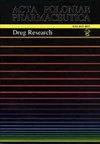TLC-densitometric identification of valproic acid
IF 0.4
4区 医学
Q4 PHARMACOLOGY & PHARMACY
引用次数: 0
Abstract
Valproic acid and its derivatives are drugs that have been used in many neurogenic diseases, but are mainly used in epileptic seizures. Due to the fact that valproic acid doesn’t have conjugated double bonds, it isn’t visible under UV light and its detection is difficult. Therefore, the aim of the study was to assess the suitability of individual visualizing reagents in the chemical qualitative and quantitative detection of valproic acid using the TLC technique. Solutions of various visualizing reagents were prepared, and then the reagents were applied on the previously prepared chromatographic plates with valproic acid by means of an immersion and spraying method in order to detect it. It was shown that all the visualizing reagents used, with the exception of helasol green, bromothymol blue, malachite green, bromocresol green in 2% sodium hydroxide solution and sulphate (VI) solutions of iron (II), nickel and cobalt, allowed for the qualitative detection of valproic acid. It is recommended to use a 1% solution of copper (II) sulphate (VI) for the detection of valproic acid for both qualitative and quantitative purposes, due to the largest areas of the chromatographic bands on most of the chromatographic plates used in the study. There is a potential possibility of examining the identity of valproic acid present in drugs on the basis of the RF value, the characteristic colour of the spot, and a comparative analysis of spectrodensitograms.薄层色谱-密度法鉴别丙戊酸
丙戊酸及其衍生物是用于许多神经源性疾病的药物,但主要用于癫痫发作。由于丙戊酸没有共轭双键,在紫外光下不可见,检测难度较大。因此,本研究的目的是评估单个可视化试剂在薄层色谱技术中丙戊酸化学定性和定量检测中的适用性。制备各种显像试剂的溶液,用浸喷法将试剂涂在预先制备的丙戊酸色谱板上进行检测。结果表明,在2%的氢氧化钠溶液和铁(II)、镍、钴的硫酸盐(VI)溶液中,除helasol绿、溴百里酚蓝、孔雀石绿、溴甲酚绿外,所有的可视化试剂均可用于丙戊酸的定性检测。由于本研究中使用的大多数色谱板上的色谱带面积最大,因此建议使用1%的硫酸铜(II)溶液进行丙戊酸的定性和定量检测。根据RF值、斑点的特征颜色和光谱密度图的比较分析,有可能检查药物中存在的丙戊酸的身份。
本文章由计算机程序翻译,如有差异,请以英文原文为准。
求助全文
约1分钟内获得全文
求助全文
来源期刊
CiteScore
0.80
自引率
0.00%
发文量
74
审稿时长
6-12 weeks
期刊介绍:
The international journal of the Polish Pharmaceutical Society is published in 6 issues a year. The journal offers Open Access publication of original research papers, short communications and reviews written in English, in all areas of pharmaceutical sciences. The following areas of pharmaceutical sciences are covered: Analysis, Biopharmacy, Drug Biochemistry, Drug Synthesis, Natural Drugs, Pharmaceutical Technology, Pharmacology and General.
A bimonthly appearing in English since 1994, which continues “Acta Poloniae Pharmaceutica”, whose first issue appeared in December 1937. The war halted the activity of the journal’s creators. Issuance of “Acta Poloniae Pharmaceutica” was resumed in 1947. From 1947 the journal appeared irregularly, initially as a quarterly, then a bimonthly. In the years 1963 – 1973 alongside the Polish version appeared the English edition of the journal. Starting from 1974 only works in English are published in the journal. Since 1995 the journal has been appearing very regularly in two-month intervals (six books a year). The journal publishes original works from all fields of pharmacy, summaries of postdoctoral dissertations and laboratory notes.

 求助内容:
求助内容: 应助结果提醒方式:
应助结果提醒方式:


